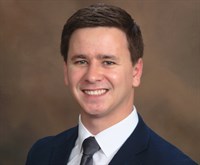 Lambert Fick, a doctoral student in the Department of Nuclear Engineering at Texas A&M University, received the Akiyama Medal for the best overall student paper as a part of the Student Paper Competition at the International Nuclear Engineering Conference (ICONE 24), held in Charlotte, North Carolina. Fick’s is the first North American student to receive the Akiyama Medal, a prestigious award presented by the Japan Society of Mechanical Engineers (JSME), in the conference’s 24-year history.
Lambert Fick, a doctoral student in the Department of Nuclear Engineering at Texas A&M University, received the Akiyama Medal for the best overall student paper as a part of the Student Paper Competition at the International Nuclear Engineering Conference (ICONE 24), held in Charlotte, North Carolina. Fick’s is the first North American student to receive the Akiyama Medal, a prestigious award presented by the Japan Society of Mechanical Engineers (JSME), in the conference’s 24-year history.
Fick’s paper reflected his research relating to a new conceptual design of pebble bed nuclear reactors and was one of more than 120 papers submitted at the conference. Fick’s research is directed toward advanced nuclear reactors of complex flow within a pebble bed design, an aspect that has traditionally represented a challenge for computational research groups.
“These flows are complex to simulate using computational tools,” Fick said. “We look at specific phenomena relating to turbulence, kinetic energy, the long term temporal instabilities and the basic engineering parameters with higher order statistics, things of that nature that help us understand and apply the physics to design safer nuclear reactors.”
Fick is an intern at Argonne National Laboratory in Chicago where he works with the lab’s nuclear engineering division. Dr. Yassin Hassan, head of the Department of Nuclear Engineering, serves as his faculty adviser.
“My day is spent staring at computer screens doing simulations on the lab’s computing system, which is pretty cool because this is one of the fastest super computer cluster systems in the world,” Fick said. “We do very high degree simulations of these fluid flows on the order of thousands or tens of thousands of CPUs at a time to do these calculations. It’s pretty impressive stuff.”
Fick and the computational team use geometries to simulate these flows and delve into the physics behind these reactor designs. Based on the understanding they generate from the simulations, they are able to extrapolate different developmental models to reduce computational costs to a design project.
After having interned at Argonne for three years, Fick is hoping to pursue a position at the lab after receiving his Ph.D., and continuing his work related to advanced nuclear reactors.
“We make some small incremental steps forward in our knowledge at a time, but the fact that we work on spherical or complex domains with a lot of curvature is a pretty novel thing,” Fick said. “I’m really interested in continuing this line of research since I feel that it really has some potential to impact the broad engineering community in a positive way.”